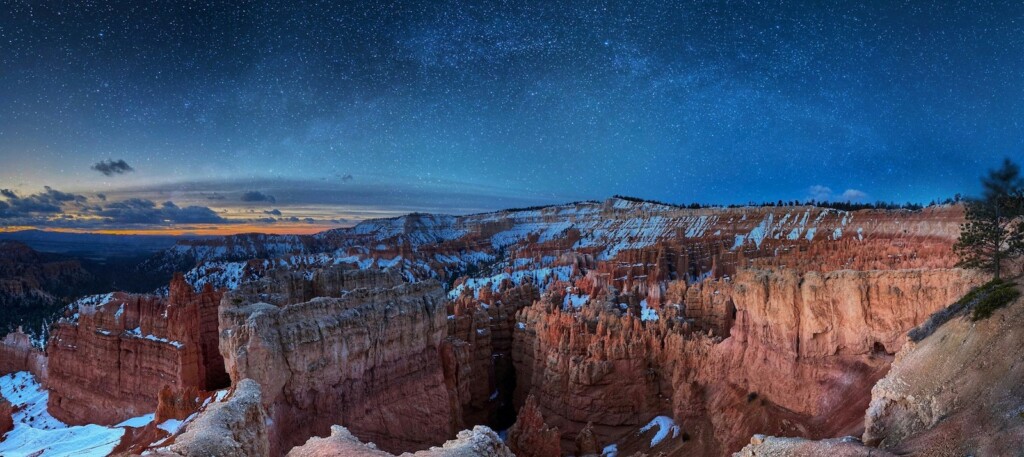At the top of a set of steps leading down to the Moab Museum of Film and Western Heritage, a prop statue, perhaps ten feet tall, represents an Egyptian figure carved in sandstone. It’s from the 1997 movie Passion in the Desert, which is set in Egypt and was partly filmed in Moab. Above the passage at the foot of the steps hangs a black-and-white poster of actors John Wayne and Maureen O’Hara, embracing as their characters in the 1950 John Ford film Rio Grande, which was filmed almost entirely at White’s Ranch near Moab.
White’s Ranch later became Red Cliffs Lodge, a currently operating resort along the Colorado River. It’s home to the Moab Museum of Film and Western Heritage, and was a favorite location for Ford. He used locations all over Southeast Utah as backdrops for many of his famous Westerns, giving the region the nickname “John Ford Country.”
John Ford Country
Elise Park, director of the Moab Museum of Film and Western Heritage, offered a brief insight into film history to illustrate the significance of Ford’s Westerns. In the early days of film, American movies hadn’t really found an identity, she said. They weren’t considered as masterful as Italian or French movies. Ford was instrumental in establishing an American style in film, and his movies influenced art and culture around the world. His Westerns aren’t just good within the genre, “These are some of the best films ever made,” Park said, noting that Ford’s Westerns, such as 1956’s The Searchers, regularly appear on contemporary “best movies ever” lists. The Searchers was partly filmed in Monument Valley, Arizona, south of Moab.
Ford didn’t exclusively make Westerns — he’s still known for other classics such as The Grapes of Wrath and The Quiet Man. But it’s arguable that the Western genre he helped to develop had an outsized influence on popular culture. The towers and red rocks of Southeast Utah form the mental image of the American Southwest for consumers of Western films around the world, and the American cowboy is a globally recognized folk figure.
Moabites got on board with Ford’s movies. George White, owner of White’s Ranch, started the Moab Film Commission in 1949, and helped facilitate logistics for the movie makers. Ford sometimes used George White’s ranch as a shooting location; cast and crew would stay in local motels or people’s homes; Ford would hire extras from town and from the Navajo Nation, and lease horses and cattle from local ranchers.

Film producers sometimes even contributed to local infrastructure, improving roads necessary to reach set locations. In 1949 a local newspaper reported on a friendly softball game with crew working on the film Wagon Master competing against locals. The locals won by a narrow margin, though the article pointed out that locals were keeping score.
The nickname “John Ford Country” has persisted, but Ford wasn’t the only director to feature Southeast Utah and surrounding areas in Westerns. Other filmmakers, including George Sherman and Gordon Douglas, also used the Moab area for their Western movies over many decades.
Film thrives in Moab
Lots of non-Western movies have also been made in the Moab area since the John Ford heyday. The quaint museum in the Red Cliffs Lodge basement displays memorabilia from films such as 1989’s Indiana Jones and the Last Crusade (part of which was filmed in Arches National Park) and 1991’s Thelma and Louise (the climax scene of which was filmed in Dead Horse Point State Park). The landscape’s buttes, cliffs and canyons have served as the setting for action movies, alien-planet movies, and road trip movies.
Film activity in the Moab area has ebbed and flowed at different times through the years, but it’s always operating. The Moab to Monument Valley Film Commission — an evolution of George White’s Moab Film Commission, and probably the longest-running film commission in the world — has helped facilitate a steady flow of projects, including TV shows, commercials and music videos in addition to movies.
A high-profile film project is underway in Moab right now: Director Kevin Costner is using Southeast Utah for much of the filming of his multipart Western epic, Horizon: An American Saga. A 2022 press release from the Utah Film Commission said the project would film in Emery, Grand, Kane, San Juan and Washington counties, and it was estimated that it would spend about $54 million in Utah. A casting call in Moab in the summer of 2022 brought locals in droves hoping to be cast as extras.
An amendment to the state’s tax incentive package for the film industry, passed in 2022, was a major factor in Costner’s choice of filming location, the director told media outlets. The updated incentives made Utah more competitive as a film destination, especially rural parts of the state. That bodes well for the future of filming in Moab.

New projects likely won’t all be Westerns. Moab’s scenery makes a great stand-in for an alien planet, for example. But Southeast Utah will always be a candidate for the genre. While film critics perennially pronounce Western films as being “dead,” Park said, the genre keeps rising again.
“Five years later, something like Yellowstone will come out and prove them completely wrong,” she said. The Western saga, Yellowstone (which stars Costner), is one of the most popular shows on TV.
“Westerns are clearly here to stay,” Park said.
The Moab Museum of Film and Western Heritage will receive a major update in 2024.






